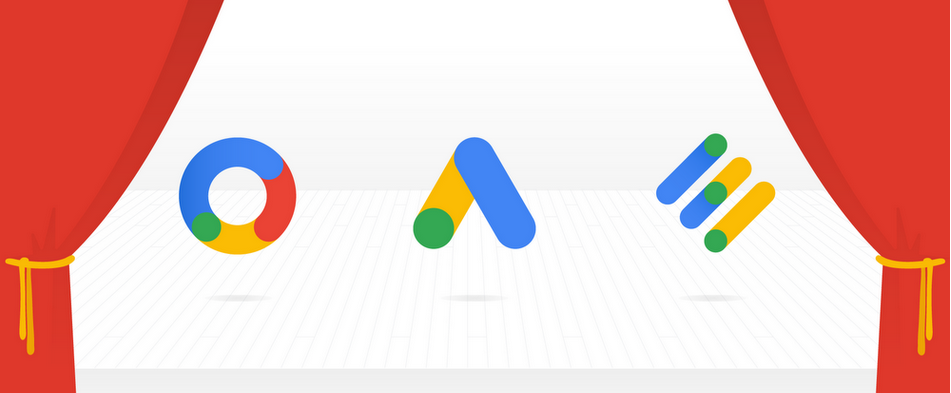Google has officially announced it is introducing new brands for advertising and marketing platforms.
This is to help advertisers and marketers connect with potential customers, and allow businesses to make simpler decisions when it comes to choosing the correct Google products for what they are looking for.
Sridhar Ramaswamy, the Senior Vice President of Ads & Commerce at Google, wrote:
We launched AdWords nearly 18 years ago with a simple goal—to make it easier for people to connect online with businesses. A search for eco-friendly stationery, quilting supplies, or for a service like a treehouse builder gave us an opportunity to deliver valuable ads that were useful and relevant in the moment. That idea was the start of our first advertising product, and led to the ads business we have today.
A lot has changed since then. Mobile is now a huge part of our everyday lives. People quickly switch from searching for products, to watching videos, browsing content, playing games and more. As a result, marketers have more opportunities to reach consumers across channels, screens and formats. Advertising on Google has evolved too—from helping marketers connect with people on Google Search, to helping them connect at every step of the consumer journey. As the opportunity to engage consumers has grown and become more complex, we are simplifying our products for advertisers and publishers of all sizes so they can more easily reach consumers anywhere, at any moment and on any channel.

Google AdWords > Google Ads
Google AdWords is now becoming simply Google Ads.
This now stands for the full range of advertising Google has to offer, across Google itself and other properties and partners. Whether this is on YouTube, Maps, the Play Store or otherwise.
Google AdWords grew from a platform based solely around text ads back in 2000 – and has become a platform supporting a vast array of formats with a network of partner sites and apps.
The AdWords interface will become the default way to engage with the platform in the near future, as they aim to simplify the ad experience.
DoubleClick > Google Marketing Platform
DoubleClick and Google Analytics 360 Suite now come under the same brand banner of Google Marketing Platform
DoubleClick for Publishers alongside DoubleClick Ad Exchange have also now been integrated into one platform which is simply named Google Ad Manager.
Enterprise customers of Google will now use this platform for planning, buying, measuring and managing digital media buys under one platform.
Display & Video 360 entails of display advertising products, including DoubleClick Bid Manager, DoubleClick Campaign Manager, DoubleClick Studio and Google Audience Center 360.
DoubleClick Search will now be called Search Ads 360.
Google Marketing Platform also now includes Data Studio, Optimize 360, Tag Manager 360 and Surveys 360.
Google Ad Manager bundles together DoubleClick for Publishers along with DoubleClick Ad Exchange. DoubleClick Ad Exchange allows publishers to sell advertising inventory.
Ad Manager aims to help mentise places where people are engaging online, whether that’s through the internet, apps, on videos or connected devices.
These changes have been a long time coming, and may seem overly confusing for no good reason. But it makes sense.
When AdWords was created, it was a world where you’d do a Google search on your desktop or laptop when you’re around at home.
But nowadays, people are searching all day. They will search first thing in the morning, at work, on their mobile at work, and once they get home maybe they’ll switch to a tablet. Or a laptop. Anything is possible.
This restructuring helps Google (and advertisers) reach prospects at every step of the funnel. AdWords was simply an outdated brand name and concept. It’s much more than that now, and Google’s entire platform needs to showcase this fact.
“Google Ads” as it is now known encapsulates exactly what it is. Ads served by Google. “Words” isn’t a part of it. Because it includes so much more than words.
Not only that, but Google is also focusing down on appealing to audiences, rather than just keywords. Search is a big part of Google, but they have become an advertising company, and audiences plays a big, big part of that. Google Ads can now take a more holistic approach, rather than the more disjointed approach it previously took using different tools and platforms for different objectives.
The next stages
The changes will roll out from July over the course of the next few months.
While these changes don’t mean much for marketers, as the products are largely staying the same, it shows the direction Google is going with its advertising and marketing products.
With more consumers shopping on mobile phones, along with their expectations from platforms on mobile devices growing, advertisers must adapt to stay in-line with what potential customers expect.


